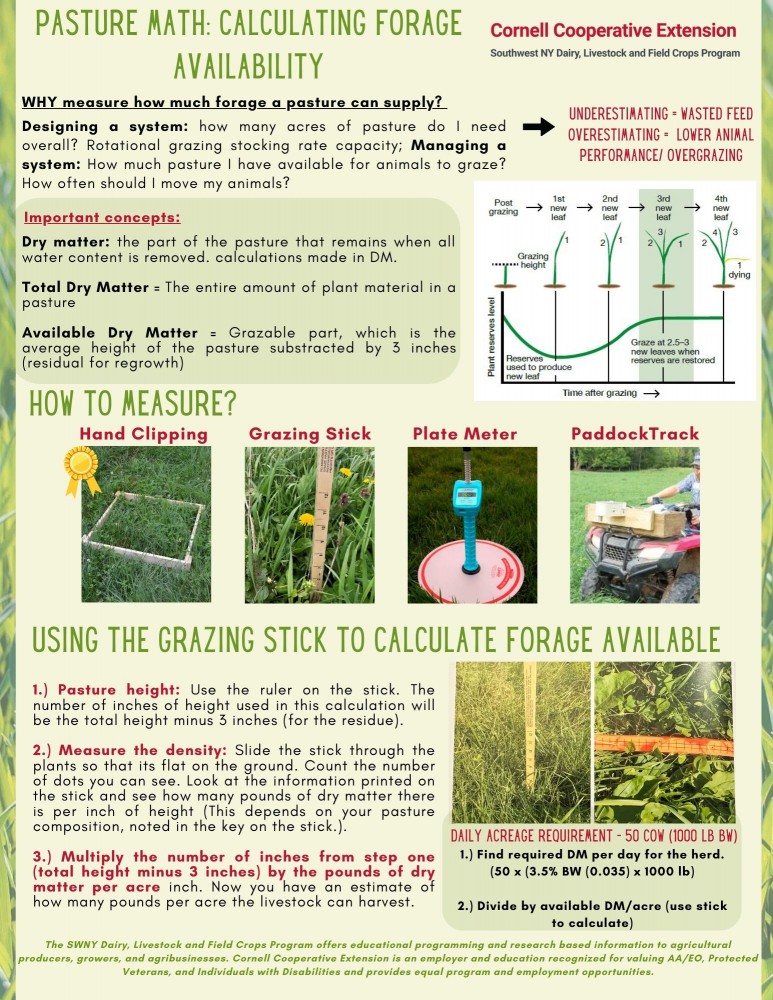Mastering Pasture Management with Grazing Stick: A Pro Farmer's Tool for Success
Camila Lage, Dairy Management Specialist
Southwest New York Dairy, Livestock and Field Crops Program
Mastering Pasture Management with Grazing Stick: A Pro Farmer's Tool for Success
The grazing stick is a valuable tool for farmers to measure pasture dry matter and estimate the available forage for their livestock. Its importance lies in providing a quick, practical, and calibrated measurement system to assess the grazing potential of a pasture. While using the grazing stick, it's essential to take multiple samples from various areas to ensure a representative value of the pasture's dry matter. This helps account for variations in the pasture's growth and grazing potential.
How to Use a Grazing Stick:
Measure Total Forage Height: Use the ruler on the grazing stick to measure the total height of the forage. Subtract 3 inches from the total height to account for residual forage that should not be considered grazable material. To accurately gauge the average leaf height of the grass in trampled vegetation, hold the foliage upright in one hand, excluding stems and seed heads of tall grasses from the measurement for precise results. A good rule of thumb for large pastures is that grazing stick measurements should be taken at least 15-to-20 locations within a pasture. In smaller pastures, 7-10 measurements may give you an accurate measurement.
Measure Density: Slide the grazing stick through the plants, keeping it flat on the ground at the soil surface. Observe the number of dots visible on the stick, which corresponds to the pounds of dry matter per inch of height.
Calculate Estimated Harvest: Multiply the number of inches from step one (total height minus 3 inches) by the pounds of dry matter per acre inch. This calculation estimates how many pounds per acre the livestock can harvest.
Using the grazing stick help farmers have an accurate understanding of the available dry matter in their pastures. This knowledge is crucial for proper pasture management, preventing wastage of feed, and avoiding situations where the livestock may suffer from insufficient forage. By implementing short grazing and adequate recovery periods, farmers can successfully maintain a healthy grazing system that benefits both the livestock and the pasture's overall health.
For assistance and guidance on how to get and use grazing sticks effectively, contact Camila Lage at 607-422-6788 or cd546@cornell.edu
You can also contact your local NRCS (Natural Resources Conservation Service) office for a grazing stick. They also provide resources and support to farmers for sustainable pasture management and grazing practices.

PDF Grazing Stick Handout (pdf; 6568KB)
Upcoming Events
Crops, Cows & Critters - Southwest New York Dairy, Livestock & Field Crops Newsletter Sponsorship
December 19, 2025
Our two forms of publications feature research-based and timely information from our four specialists, listed to the right, along with local event notifications and Cornell University outreach. This information is provided to participants who range from dairy, livestock, and field crops producers to agricultural suppliers and consultants.
Weekly Email Update: Shared with 625+ households who have signed up with our program.
Monthly Paper Mailer: To reach our stakeholders and farmers who lack internet access, we send out a monthly mailer where your company's logo and contact information would be featured with a mailing list of 330+ households.
If you sponsor our weekly and monthly publications you reach approximately 955 households.
Visit our website to view our newsletters!
2025 Cornell Food Beverage & Animal Feed Manufacturer Survey
December 19, 2025
Industry and Educational Advocates for New York State's Food, Beverage, and Animal Feed Manufacturing industries:
As you know, NYS has a diverse food and beverage manufacturing industry, in both the types of industries that exist and the wide distribution of firms by scale. Many manufacturing firms have strong backward linkages to agricultural production sectors in the state that support both farm-level and downstream food industry firms and consumers. In collaboration with the New York State Department of Agriculture and Markets, a team from Cornell University's Charles H. Dyson School of Applied Economics and Management has recently rolled out the 2025 New York State Food, Beverage, and Animal Feed Manufacturer Survey. The industry will benefit from an updated assessment of the industry that informs private and public investments and opportunities to support firm growth and improved profitability.
Cornell Organic Field Crops & Dairy Conference
March 6, 2026
Waterloo, NY
Farmers, researchers, educators, and agricultural service providers from across the Northeast are invited to the 2026 Cornell Organic Field Crops & Dairy Conference, held Friday, March 6, 2026, from 8:00 a.m. to 4:30 p.m. at the Lux Hotel & Conference Center in Waterloo, N.Y.
Co-hosted by New York Soil Health and Cornell CALS, the annual conference brings together leaders in organic grain, dairy, and livestock systems to share practical tools, new research, and farmer-tested strategies to support resilient and profitable organic production.
Announcements
No announcements at this time.





